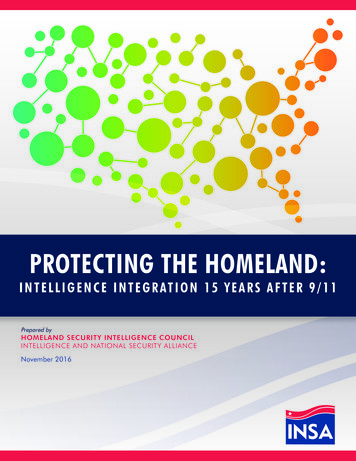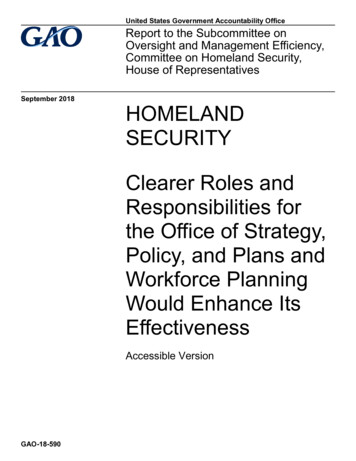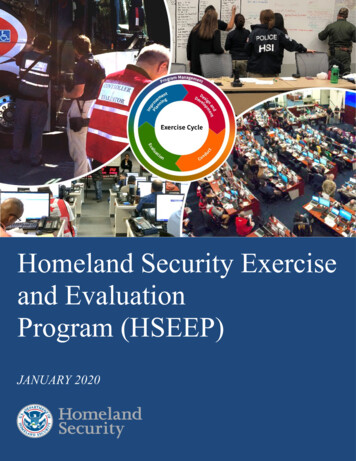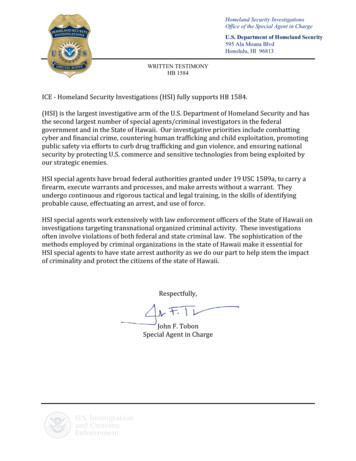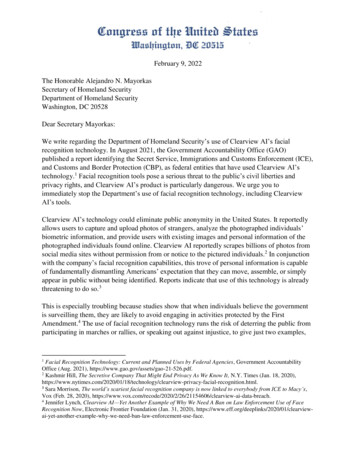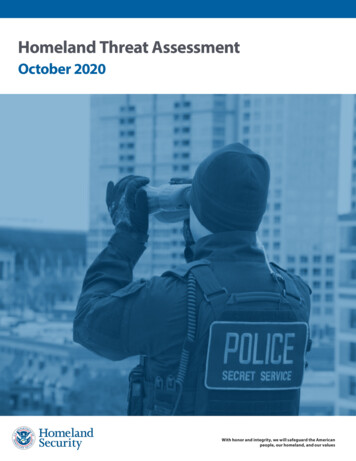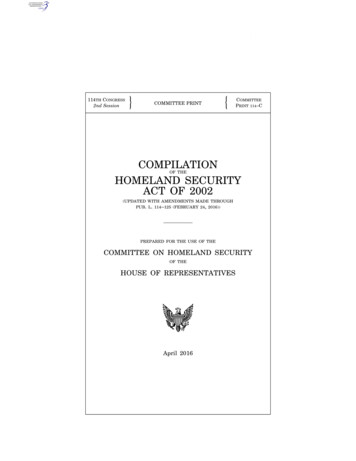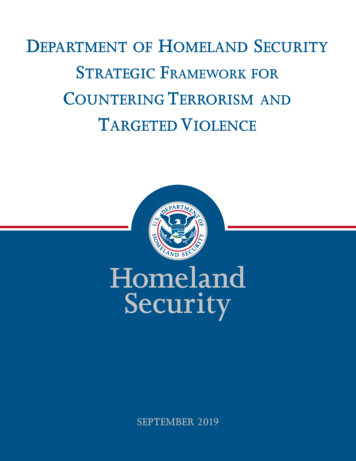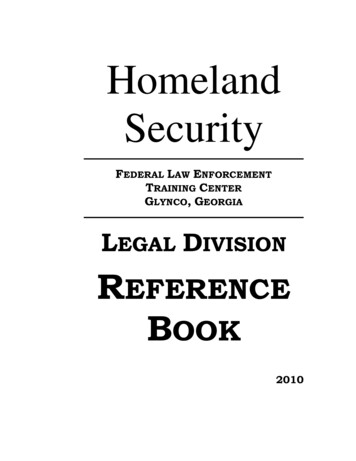
Transcription
Introduction toHomeland SecurityFourth EditionPRELIMS.indd i11/19/2011 5:04:22 PM
PRELIMS.indd ii11/19/2011 5:04:22 PM
Introduction toHomeland SecurityPrinciples of All-HazardsRisk ManagementFourth EditionJane A. BullockGeorge D. HaddowDamon P. CoppolaAMSTERDAM BOSTON HEIDELBERG LONDONNEW YORK OXFORD PARIS SAN DIEGOSAN FRANCISCO SINGAPORE SYDNEY TOKYOButterworth-Heinemann is an imprint of ElsevierPRELIMS.indd iii11/19/2011 5:04:22 PM
Acquiring Editor: Pam ChesterDevelopment Editor: Greg ChalsonProject Manager: Paul GottehrerDesigner: Eric DeCiccoButterworth-Heinemann is an imprint of Elsevier225 Wyman Street, Waltham, MA 02451, USA 2013 Elsevier, Inc. All rights reserved.No part of this publication may be reproduced or transmitted in any form or by any means, electronic or mechanical,including photocopying, recording, or any information storage and retrieval system, without permission in writing fromthe publisher. Details on how to seek permission, further information about the Publisher’s permissions policies and ourarrangements with organizations such as the Copyright Clearance Center and the Copyright Licensing Agency, can befound at our website: www.elsevier.com/permissions.This book and the individual contributions contained in it are protected under copyright by the Publisher (other than asmay be noted herein).NoticesKnowledge and best practice in this field are constantly changing. As new research and experience broaden ourunderstanding, changes in research methods or professional practices, may become necessary. Practitioners andresearchers must always rely on their own experience and knowledge in evaluating and using any information ormethods described herein. In using such information or methods they should be mindful of their own safety and thesafety of others, including parties for whom they have a professional responsibility.To the fullest extent of the law, neither the Publisher nor the authors, contributors, or editors, assume any liability forany injury and/or damage to persons or property as a matter of product liability, negligence or otherwise, or from anyuse or operation of any methods, products, instructions, or ideas contained in the material herein.Library of Congress Cataloging-in-Publication DataApplication submittedBritish Library Cataloguing-in-Publication DataA catalogue record for this book is available from the British Library.ISBN: 978-0-12-415802-3For information on all BH publicationsvisit our website at www.elsevierdirect.com/securityPrinted in China13 14 15 16 17ITR1.indd iv10 9 8 7 6 5 4 3 2 111/19/2011 5:00:28 PM
DedicationThis book is dedicated to Dr. Wayne Blanchard. Dr. Wayne provided the vision, leadership, and supportto higher education institutions across the United States to establish programs in emergency managementand homeland security. Because of his efforts, emergency management moved from being an ad hoc discipline to an education-driven profession. In doing so, he fostered a diverse, highly trained cadre of emergency managers to better serve the people in USA. On a personal note, Wayne had a great sense of humor,was an innovator in dealing with the bureaucracy, and was a constant source of friendship and support toall of us who worked with him over the years.vDED.indd v11/19/2011 5:03:36 PM
DED.indd vi11/19/2011 5:03:36 PM
d Security: The Concept, the OrganizationWhat You Will LearnIntroductionA New Concept of Homeland SecurityThe Department of Homeland SecurityOther Federal Departments Responsible for the Homeland Security EnterpriseConclusionKey TermsReview Questions111714172122232.Historic Overview of the Terrorist ThreatWhat You Will LearnIntroductionBefore It Was Called Homeland Security: From the 1800s to the Creationof FEMAWorld Trade Center BombingMurrah Federal Building BombingKhobar Towers Bombing, Saudi ArabiaUSS Cole Bombing, YemenSeptember 11 Attacks on the World Trade Center and the PentagonThe Creation of the Department of Homeland Security: 2001–2004The 9/11 CommissionHomeland Security Focus on Terrorism Results in a Disaster: Hurricane Katrinaand Its AftermathObama AdministrationConclusionKey TermsReview S1.indd vii11/21/2011 8:03:34 PM
viii CONTENTS3.Hazards57What You Will LearnIntroductionThe HazardsNatural HazardsTechnological HazardsTerrorism HazardsConventional Explosives and Secondary DevicesChemical AgentsBiological AgentsNuclear/RadiologicalPreparedness and Sheltering in PlaceCombined HazardsDifficulty of Predicting Terror Attacks in the United StatesConclusionKey TermsReview ental Homeland Security StructuresWhat You Will LearnIntroductionDepartment of Homeland Security Organizational ChartThe Office of the Secretary of Homeland SecurityAgency ReorganizationDHS BudgetOther Agencies Participating in Community-Level FundingActivities by State and Local OrganizationsHomeland Security Activity of State and Tribal GovernmentsLocal Government Homeland Security ActivitiesOther Homeland Security StructuresConclusionKey TermsReview 5.Intelligence and CounterterrorismWhat You Will LearnIntroductionThe Intelligence CommunityOffice of the Director of National IntelligenceDefense Intelligence AgencyThe Federal Bureau of Investigation (Department of Justice)National Geospatial-Intelligence AgencyNational Reconnaissance OfficeNational Security Agency177177177177184193194195198200PRELIMS1.indd viii11/21/2011 8:03:34 PM
Contents ixDHS Office of Intelligence and AnalysisDepartment of State Bureau of Intelligence and ResearchConclusionKey TermsReview Questions2012012022022036.Border Security, Immigration, and Customs EnforcementWhat You Will LearnIntroductionBorder SecurityImmigrationCustoms EnforcementBorder Security, Immigration, and Customs in the Department of Homeland SecurityU.S. Customs and Border ProtectionU.S. Immigration and Customs EnforcementThe U.S. Coast GuardU.S. Citizenship and Immigration ServicesOffice of US-VISITConclusionKey TermsReview 02417.Transportation Safety and SecurityWhat You Will LearnIntroductionThe Transportation NetworkThe Transportation Security AdministrationTSA ComponentsTrucking SecurityBus Transportation SecurityRailway Transportation SecurityConclusionKey TermsReview ersecurity and Critical Infrastructure ProtectionWhat You Will LearnIntroductionCybersecurityDHS Cybersecurity EffortsDOD Cybersecurity EffortsCybersecurity Efforts of Other Federal AgenciesDHS Response to the 9/11 Commission RecommendationsRecent d ix11/21/2011 8:03:34 PM
x CONTENTSCritical Infrastructure ProtectionState and Local GovernmentsPrivate SectorInternationalConclusionKey TermsReview Questions9. All-Hazards Emergency Response and RecoveryWhat You Will LearnIntroductionResponse ProcessesLegislative ActionsBudgetLocal ResponseFirst-Responder Roles and ResponsibilitiesLocal Emergency ManagersFunding for First RespondersState ResponseVolunteer Group ResponseDHS Response AgenciesOther Response AgenciesNational Incident Management System (NIMS)Federal ResponseNational Response Framework (NRF)RecoveryFEMA’s Individual Assistance Recovery ProgramsPublic Assistance ProgramsConclusionKey TermsReview Questions10. Mitigation, Prevention, and PreparednessWhat You Will LearnIntroductionMitigation Plans, Actions, and ProgramsPrevention Actions and ProgramsPreparedness Actions and ProgramsPreparedness Against Biological and Chemical Attacks and AccidentsComprehensive Medical and Health Incident Management SystemNuclear and Radiological PreparednessTerrorism Preparedness and Mitigation: Community IssuesThe Role of the Private Sector in Mitigation and Preparedness ActivitiesExercises to Foster PreparednessPRELIMS1.indd 43845145245746046246247648411/21/2011 8:03:34 PM
Contents xiConclusionKey TermsReview Questions48848849011. CommunicationsWhat You Will LearnIntroductionRisk CommunicationWarningCrisis CommunicationsKey TermsReview Questions49549549549651051456556512. Science and TechnologyWhat You Will LearnIntroductionOverview of Involved Agencies and BudgetsDepartment of Homeland SecurityR&D Efforts Focused on Weapons of Mass DestructionEfforts Aimed at Information and InfrastructureLaboratories and Research FacilitiesR&D Efforts External to the Department of Homeland SecurityConclusionKey TermsReview Questions57357357357457459359660160961161361313. The Future of Homeland SecurityIntroductionThe FEMA History LessonLessons for Homeland Security from the FEMA ExperienceThe Future of Emergency Management in Homeland S1.indd xi11/21/2011 8:03:34 PM
PRELIMS1.indd xii11/21/2011 8:03:34 PM
AcknowledgmentsThe authors of this book would like to express their appreciation for the continued support andencouragement we have received from Dr. Jack Harrald, Dr. Joseph Barbera, and Dr. Greg Shaw. In addition to contributing a large dose of practical advice and humor, these three individuals provide outstandingleadership to institutions and governments in designing and implementing homeland security projects.We would like to acknowledge the many individuals whose research, analysis, and opinions helpedto shape the content of this volume.We would also like to thank Pam Chester, Greg Chalson, and Paul Gottehrer at Elsevier for theirassistance in making the fourth edition of this text possible, and for their patience and faith in us. Ourgratitude also extends to Barbara Johnson, Ryan Miller, Ehren Ngo, Bridger McGaw, Don Goff, JackSuwanlert, Sarp Yeletaysi, Erdem Ergin, Lissa Westerman, Terry Downes, Steve Carter, and DavidGilmore.Finally, we recognize the thousands of professionals and volunteers who, through their dailypursuits, are giving form and substance to creating a more secure and safe homeland.xiiiACK.indd xiii11/19/2011 5:01:36 PM
ACK.indd xiv11/19/2011 5:01:36 PM
IntroductionIt has been 10 years since the events of September 11 precipitated a dramatic series of actions in responseto those events. The National Commission on Terrorist Attacks upon the United States (informallyknown as the 9/11 Commission) was formed and issued a report calling for sweeping changes in the U.S.approach for dealing with terrorism. The Department of Homeland Security (DHS) was established, themost comprehensive reorganization of the federal government ever undertaken. Congress continued topass new laws to address all aspects of national security, including the Patriot Act, which provides theAttorney General of the United States with significant new authority relative to civil liberties to fightthe war on terrorism.The United States and its allies became embroiled in two significant wars in Iraq and Afghanistan totry to find and dismantle Osama bin Laden’s operations and other terrorist organizations.Significant progress has been made as demonstrated by the disruption of a potential threat inNew York’s Times Square, the failed attempt to detonate explosives on Flight 253 on December 25, 2009,and the publication of the first-ever Quadrennial Homeland Security Review (QHSR) by the DHS inFebruary 2010. Perhaps the most significant action has been the capture and killing of Osama bin Ladenin 2011 as well as other key leaders in his organization.With the U.S. government being increasingly focused on terrorism, natural hazards have continued to impact thousands of our communities, reminding us that the likelihood of a natural disaster farexceeds a terrorist event. The aftermath of Hurricane Katrina brought sweeping legislative changes tothe Federal Emergency Management Agency (FEMA), within DHS, and served to remind officials of theexacting toll natural disasters can take on public safety and our social and economic security. The devastating wildfires, floods, weather, and drought problems that impacted the Nation in 2011 continuedthis trend, although the response from FEMA/DHS and other partners was much improved. Striking theright balance, between the various hazards, looking for commonalities among the hazards in mitigation,preparedness, response, and recovery, and adopting a more all-hazards approach to homeland securityremain priorities for the officials responsible for public safety.At the same time, concerns continue to be raised on the impacts of illegal and legal immigrationon the economic and social stability of our communities, especially along the border areas that consumethe activities of the Immigration and Customs Enforcement (ICE). The Coast Guard (CG) is vigilant inmaintaining territorial waters and safety and security at our ports that are of the highest priority to ensurehomeland commerce can continue.New emerging and evolving threats require greater attention to cybersecurity, preventing cybercrime, and protecting our critical infrastructure. The complexities and speed with which the cyber environment changes require a diligence and a level of cooperation and coordination between the governmentand the private sector not evidenced before. As more of our daily lives are dependent on the continualoperation of computers and computer systems, for example, transportation, energy, and banking systems,preventing an attack on these systems becomes a critical priority for homeland security officials.xvITR2.indd xv11/19/2011 5:02:37 PM
xvi INTRODUCTIONVicksburg, MS, May 12, 2001 – The lower floor of the historic Yazoo Mississippi Valley Railroad Station, which is located in Vicksburg,Mississippi, is submerged by the rising Mississippi River. FEMA is working with local, state, and other federal agencies to assistresidents affected by the floods. (Photo by Howard Greenblatt/FEMA)Galveston Island, TX, September 20, 2008 – The U.S. Coast Guard patrol boat USCGC Manowar continues missions in the intercoastalwaterway after Hurricane Ike. (Photo by Jocelyn Augustino/FEMA)This Fourth Edition reflects the evolving environment of homeland security and includes structuralchanges to allow focus on more urgent threats such as cybersecurity and new public policy initiativeswhile still providing the hazards context and the historic and organizational framework of homelandsecurity operations.ITR2.indd xvi11/19/2011 5:02:37 PM
Introduction xviiThe first chapter is intended to introduce the concept of homeland security and how that concepthas changed in the 10 years since the events of September 11, where there is finally a recognition thatthere needs to be a balance between the terrorism threat and natural and other hazards fueled by thetrauma of the failed response to Hurricane Katrina.The second chapter provides a historical perspective on the terrorist events that precededSeptember 11 and how the government’s mechanisms to respond to emergencies have evolved, includingdescriptions of the statutory actions that were taken in reaction to September 11 and in support of preventing future attacks.The book continues with complete descriptions and fact sheets on the types of hazards and risksthat make up the potential homeland security vulnerabilities from future terrorist events, natural hazards,or human-made hazards. This section is followed by an overview presentation of the organization of DHSso that subsequent chapters and discussions will have a structural context.In the revised format, we have developed chapters that describe the programs and actions beingundertaken by government agencies, organizations, and the private sector to reduce or minimize thethreat. We have focused chapters on the areas of intelligence and counterterrorism, border security andimmigration, transportation safety and security, and cybersecurity and critical infrastructure protection.A significant section is devoted to all-hazards response and recovery as these responsibilities arenow recognized as a primary focus for DHS. In this chapter, we describe the current state of the art infirst responder applications and discuss the changes that are under way within the national responseand recovery system network. This is followed with a chapter focused on mitigation, prevention, andpreparedness.Recognizing the critical role that communications now play in our everyday lives and the use ofsocial media in emergencies are now highlighted in a separate chapter, as are advancements in science andtechnology that support the homeland security enterprise mission.We have included more case studies to demonstrate practical application to the materials being presented. In addition, we have included full texts of critical guidance documents, directives, and legislationfor use and reference. Wherever possible, budget and resource charts show past allocations and futureprojections through 2011.The volume concludes with a chapter that examines potential future and still unresolved issues thatare relative to the disciplines of homeland security, with more of focus on public safety and emergencymanagement that must be addressed as we meet the challenges of establishing a secure homeland.Homeland security is a still-evolving discipline, changing to adapt to new threats and challenges.This book was written at a particular point in time, and changes to programs, activities, and even organizations occur regularly. For that reason we have included online references wherever possible so thereader will have access to websites that can provide up-to-date information on program or organizationchanges, new initiatives, or simply more detail on specific issues.The authors’ goal in writing this book was to provide a source of history, practical information, programs, references, and best practices so that any academic, homeland security official, emergency manager, public safety official, community leader, or individual could understand the foundationsof homeland security and be motivated to engage in actions to help make their communities saferand more secure. The homeland security function clearly is an evolving discipline that will continue tochange in reaction to the steps we take to reduce the impacts of known hazards and as new threats areidentified.In the end, achieving homeland security will not be accomplished by the federal government butby each individual, each organization, each business, and each community working together to make adifference.ITR2.indd xvii11/19/2011 5:02:40 PM
1. Homeland Security: The Concept, the Organization 1 What You Will Learn 1 Introduction 1 A New Concept of Homeland Security 7 The Department of Homeland Security 14 Other Federal Departments Responsible for the Homeland Security Enterp
